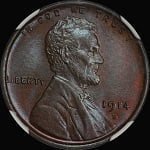Anyone ever see a damaged die like this one?
Just got this photo back from Todd. As you can see, it has an interesting die chunk in the middle of the reverse. I found this 1862 Indian cent at the San Francisco Mint Show and gave it to Rick to attribute. He said it was a new variety, and gave it a Snow 9. I posted the new attribution page of this coin (and another new 1862 variety I found) a few weeks ago, but here it is again. Has anyone ever seen one like this before?




0



Comments
The Penny Lady®
My initial thought was an internal major die break (cud). But after thinking about it a bit more, I agree it is a damaged die.* An internal major die break should not have left the "E" and the top of the "N" intact, but would have likely included them as part of the die failure (break). Also, the die does not appear to be stressed to the point where an internal major die break would occur. I would have anticipated seeing more evidence of die wear, die breaks/cracks, or die fatigue elsewhere on the coin.
Very cool, nonetheless.
Lane
*Then I actually read Rick's description!
See http://www.doubledimes.com for a free online reference for US twenty-cent pieces
Nice!
TD
collapse). The 1855 large cent-knob on ear variety is an example. I also have a so-called dollar--General Tom Thumb with a reverse that has an oblong, balloon-like, raised spot on the reverse.
RMR: 'Wer, wenn ich schriee, hörte mich denn aus der Engel Ordnungen?'
CJ: 'No one!' [Ain't no angels in the coin biz]
Also, if you did displace that much die steel with an impact of great force, there should be a crater effect around the depression.
--
Having read what I just wrote above, what do you think of this: The reverse die received its initial hubbing impression, was taken out and annealed, and when it was put back into the hubbing press a small scrap of die steel fell onto the partially-hubbed die. The hub came down and impressed that scrap steel into the die, driving the corner of the E deeper into the die without totally obliterating it.
Does it look like the top of the N of CENT is slightly distorted as well?
TD
<< <i>I'd call that simply struck-through debris, but at the hubbing stage of the die. It was on the die when the die received one of the strikes from the hub. If you'll look closely at that lower-left corner of the impacted E you'll see the outline of the debris running over that corner. >>
I think I said that........
An authorized PCGS dealer, and a contributor to the Red Book.
<< <i>
<< <i>I'd call that simply struck-through debris, but at the hubbing stage of the die. It was on the die when the die received one of the strikes from the hub. If you'll look closely at that lower-left corner of the impacted E you'll see the outline of the debris running over that corner. >>
I think I said that........
You're right, your last theory was, "a small scrap of die steel fell onto the partially-hubbed die." That's close enough. Credit me with an assist, how's that?
In honor of the memory of Cpl. Michael E. Thompson
<< <i>It's the little known spawning salmon variety.
I think I said that. Or if I didn't I think I was thinking of saying that.
No way......nope I'm not going to say it.....
Still waiting for Rick Snow to chime in on my theory.
TD
<< <i>No way......nope I'm not going to say it..... >>
Was thinking the same thing.
<< <i>No way......nope I'm not going to say it..... >>
Say what?
The name is LEE!
<< <i>
<< <i>No way......nope I'm not going to say it..... >>
Say what?
What he thinks it looks like. . .
<< <i>
<< <i>No way......nope I'm not going to say it..... >>
Was thinking the same thing.
Maybe we should call this the Bill Clinton Reverse variety
Sean Reynolds
"Keep in mind that most of what passes as numismatic information is no more than tested opinion at best, and marketing blather at worst. However, I try to choose my words carefully, since I know that you guys are always watching." - Joe O'Connor
The Penny Lady®
I listed this as a die defect, pre-hardening die damage. which it could be as well.
The Penny Lady®